Dhamma Shringa Vipassana Meditation Centre, Part 3
Letter #33: Are you sick of reading about this yet? I hope not because the end is worth it.
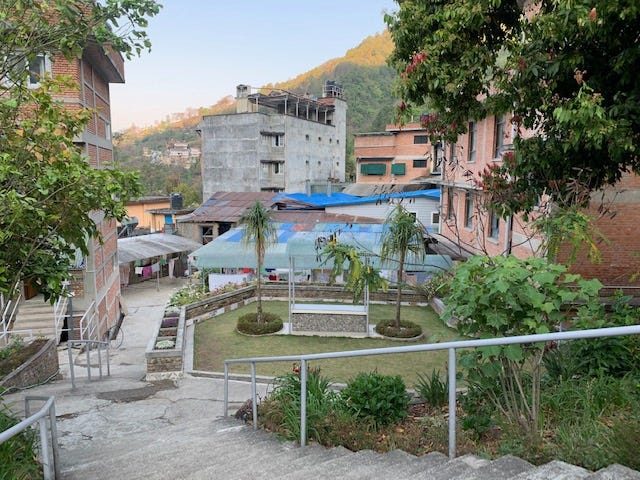
I think one of the hardest parts for me about this course was that there was no outline. I didn’t have a clear understanding of the end goal. No one was telling me exactly how it should feel. The results-oriented side of me anxiously questioned what is the point of all this?
The teacher continued to explain that you can read as many books as you want on the technique of Vipassana meditation. You can listen to as many talks of experienced individuals as you want. But until you, personally, go through the Vipassana 10-day course, and witness the technique on an experiential level, you cannot have a true understanding of how Vipassana can lead to liberation from misery. Like when we say “you can talk the talk, but can you walk the walk.” Understanding things from an intellectual level is very different from understanding from an experiential level. It was a good reminder for me to stick with it, no matter how much my doubtful mind wanted to question it.
And so, during Day 4 we moved on from focusing only on our natural breathing to the body scan of Vipassana meditation. Beginning at the top of the scalp, we’d scan the entire surface of our body, in 2 to 3 inch areas, observing any sensation that arises. It could be an itch on your eyebrow, a pulsating pain in the middle of your back, the feeling of your shirt fabric against your upper arm, or your foot falling asleep beneath your lower leg.
Whatever the sensation, we were to observe it for a while with total equanimity—no craving and no aversion. It’s nearly impossible to do this with an aching back that won’t go away no matter what position you shift into, or an itch on your face that you’re certain will be there for the rest of your life if you don’t take care of it right that instant.
We were to be careful to scan out body in a symmetrical way, from head to toe, from toe to head, being sure not to miss any part of the body. Eventually, your mind will be so sharp that you can observe the subtlest of sensations where you may otherwise think there was nothing to feel at all.
I must be extra sensitive because I found it relatively easy to observe a sensation on the entire surface of my body. But Day 4 proved incredibly painful. Being that focused meant I did slip into a true meditative state, and when I’d finally emerge, my body ached in ways I’d never experienced. Emotionally, the entire process began to take a toll on me.
But something else really amazing happened on Day 4. Remember when
told me to wait for the hit of inspiration that was so loud I couldn’t not listen to it? I realized it was happening late that morning.I had been daydreaming—HARD. Like letting my mind come up with all these stories of a future, hypothetical me. I was making up other people and imaginary landscapes and the situations I’d find myself in. I was creating full storylines for myself, when I all of a sudden had the urge to write them all down, to let my imagination create something more publicly.
Whether it turns into a “thing” or not (I don’t want to get my hopes up about my own hypothetical capabilities), writing has been a new creative passion of mine that I’ve actually stuck with, consistently, for the past 6 months. It’s not something I tried out for a couple weeks and then let die off. Now, with every experience I’m having, every conversation I’m engaged in, my mind begins to put the story together to share. I can’t even turn that brain function off anymore. And my hand can’t write fast enough to keep up with it—it helps that the content in my life is so rich and varied right now.
I had this vision of myself continuing to write, of living this nomadic lifestyle that’s been making me so happy, and having continued reasons to keep exploring and exposing myself to different cultures and situations around the world.
This was distracting me from my morning meditation, yes. But I had been patiently waiting for that moment of inspiration to click, and now my mind was quiet enough for this clarification to enter. I knew I couldn’t go back to my old life, and now I could see what my future might look like.
At the start of this journey, when asked what my goal of a self-proclaimed, self-funded sabbatical was, I said I wanted to be bored again.
And it wasn’t until the Vipassana course that I finally felt bored. That was the moment when my beautiful imagination gave me guidance. How humbled I am, and how much respect I have for my own intuition. When I listen to it and speak honestly about it, I am rewarded, even if it takes months or years for that reward to make itself evident.
That afternoon I hid under the heavy blanket on my bed, clicked open my pen as quietly as I could, and wrote out a very quick, rough outline of my ideas. I was giddy, almost grateful to have all this boring meditation time to continue riffing on these ideas.
Tomorrow would be Day 5. Only halfway through Day 5 would mean I was actually halfway through the course—I mean it when I was saying I counted down the actual hours.
I can’t remember if it was Day 3 or 4 when I asked Sofie, the volunteer from France, where the teacher was. I knew that sometimes the teachers running these centers visited locations in other parts of the world, so used voice and video recordings in place of their in-person lectures. But, when the discourses began, and the video was dated 1991…I began to question my theory.
Sofie, confused, replied “the assistant teachers?” And I said “no…the teacher in the videos". Her eyes widened in surprise as she exclaimed “he’s dead! He died 10 years ago.”
I had had a feeling that may be case because of the date of the video, otherwise why wouldn’t they have made a more recent recording since we were now in the super technological age of 2023. I was shocked at how completely relevant the teachings still were. And even his humor! His jokes had the entire room laughing, just the same as his students in 1991.
As the discourses rolled on, we learned more about S.N. Goenka. Once a wealthy business man, dealing with all the miseries that likely plague most wealthy people, he was introduced to Vipassana in the 1950’s from a teacher in Burma. He loved it so much he moved to India in 1969 to begin teaching the technique to others, and has since opened many centers around the world—he dedicated his entire life to sharing the liberation of Vipassana meditation. And so it makes sense that his instructional videos from 1991 are still used—I’m not sure how anyone could quite replicate his wisdom, humor, and compassion in his teaching.
I looked forward to the nightly discourses, in awe that he was able to identify every doubt, every thought and pain I was feeling each day—the result of thousands of students going through this course before me.
I knew he had said Day 2 and 6 would be the hardest days for most students, but Day 5 was that for me. Keep in mind that nothing changes. There isn’t some physically exhausting, hard labor activity every day. There isn’t a change in the sleep schedule. There are no mentally challenging math problems to solve, or therapy sessions where you’re digging through the emotional baggage from your childhood. The only thing that is changing is the minor adjustments to what you focus on during your body scan. The course is hard because there are no changes.
Early, EARLY in the morning on the 5th day, I woke up with another coughing attack. I couldn’t check the time but I was desperate for more sleep and felt bad for keeping my roommates awake. So I caved in, dug the cough syrup out of my bag, and took a dose of this “mildly” drowsy medicine. I laid back down, waiting for it to kick in. Unfortunately, the 4am bell rang before I fell back asleep and now the cough syrup would torture me for the next 2 hour early morning meditation.
I was nodding off non-stop, my head bobbing every time I began to lose focus—I had messed up, BIG TIME. Somehow I stuck it out, then rushed through my breakfast so I could crawl back into bed for my 7am nap, and hopefully sleep it off.
The rest of the morning was like that—we had another 3.5 hours of meditation. I was super frustrated, feeling so exhausted from the medicine, that Day 5 was the most defeating for me. I hadn’t even reached the halfway point and I was beginning to crack. I had zero confirmation that I was doing any of it right. I still didn’t know why I was there.
Here was the note I jotted down in secret that day:
Things I know: I’d never do this again. I’d rather donate money than volunteer to help the students on another course and stay here again. I don’t REALLY enjoy meditation—does anyone?!
Questioning: If all sensations are to be observed equanimously, are we supposed to never experience joy?! Does joy only lead us to craving, which leads us to clinging, which leads to misery? I have so much joy in my life right now, I wouldn’t want to live a neutral life where I do not express any elation…
I did, however, have another hit of creativity. In my mind I designed the next tattoo I want to get AND designed what I’d want my wedding right to look like. Which is SUPER funky, because, as most of you know, I’m not into traditional fine jewelry.
And so, I stayed another day. By Day 6 I was not over halfway done, yet the goal post still felt a million miles away. I’d break things down into “5 more nights of going to sleep in that bed,” and “2 more times taking a cold shower in a not-so-sanitary bathroom.” “5 more afternoons of 4.5 hour stretches of meditation.”
I switched my daily walks to the evening, around 8:15pm before the final half hour of meditation. I’d count how many stars I could see, I’d marvel at the pagoda lit up against the national forest and night sky. I’d stop for glances of the sparkling lights in the city of Kathmandu, sprawled out below us. I’d observe the budding trees along the path, welcoming the cool night air into my lungs.
I realize how cheesy all that sounds—am I turning into a sensitive, observant, mom-type that loves to tend to her garden? But I was appreciating this small ritual to move my body, having nothing to focus on but the environment around me.
Day 6 was easier as I was grateful for having the hardest day behind me. In my mind I designed my future house, complete with an office that’s set up for sewing, jewelry design, and writing, and a mudroom with an easy access dog wash. Yes, of course I put a wrap around porch off the office. 🙏🏻 Now I’d just need time to actually draw all these things out. 🤔
By Day 7, I could see that my feelings were changing hour by hour. During our mid-morning session, Goenka, over the loud speaker, instructed us to shift our focus from 2-3” areas of the surface of our body to a free flow scan of the body. We began observing larger sections of the body, symmetrically traveling from head to toe and toe to head. It was like noticing the most subtle of sensations in both your arms at the same time, remaining equanimous to the feeling. I was having trouble making the switch, and didn’t quite understand the technique until the assistant teacher explained it to us during our small group session. Once we practiced together, I had an understanding of what the free flow meant.
At that time, the assistant teacher asked me to come see her privately at noon, after lunch. Not only did this mean I’d have to skip my second nap, but the anxiety of “being called into the principal’s office” began to rise in my body. Could she tell how fidgety I was? Could she tell I was daydreaming about 6 hours out of the day, committing only 4.5 hours to actual meditation? Did she know I was secretly jotting down notes in my little journal? Did she know I rested my back against the wall when I meditated back in the dorm?
The ridiculous things going through my head, feeling like I was in trouble, clouded my thoughts, making it harder to focus on the meditation. Luckily, after explanation of free flow, I felt like I was able to achieve it, newly dedicated to being a star student until the bell rang for lunch.
I was over the taste and texture of dal, so I skipped it during both meals that day. the monkeys were out again in full force, banging around on the rough of the dining hall, jumping from building to building and into the trees. I did my laundry after lunch. The compound had several spigots outside with basins and random bars of soap. The monkeys played around above me.
In the US we don’t wash our clothes by hand outside, crouched on the ground next to a faucet. I watched how the Nepali women did it and followed suit. I worked quickly—I doubt my clothes were that clean, but good enough to get me through the remainder of the course. I hung them out to dry, then lined up to wait for the assistant teacher to call me in for our private discussion.
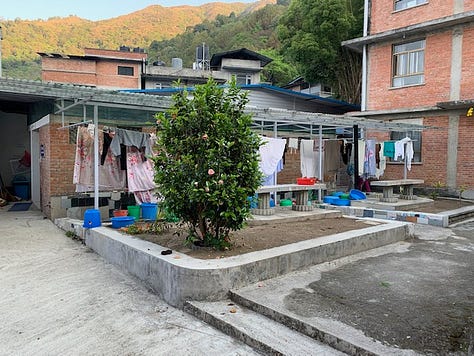
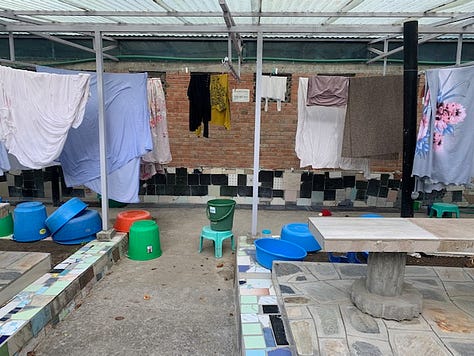

She quickly dispelled any worries I had. She’d seen in my application that I’d participated in hypnotherapy before and wanted to be sure that, while practicing Vipassana, I would not engage in other mental practices. That the result could be dangerous. I reassured I wasn’t seeing my (hypno)therapist at the moment so it was no issue for me to separate the mental techniques, but our language barrier prevented me from understanding further what could possibly be “dangerous” about mixing them. I’m not that passionate about inner works of spirituality, so sticking with only one is fine by me.
She asked how I was doing otherwise, and I admitted how hard it was to be there. That it’s painful and boring. She laughed and assured me this is very normal and to commit to staying the course. It’s amazing how much the human interaction with her that day boosted my ability to focus on the meditation AND find consolation about my negative feelings. We haven’t had any physical contact with anyone the entire course, but that kind conversation with the assistant teacher was the closest thing I felt to receiving a hug in a long time. Between her advice and Goenka’s nightly discourse, I felt less isolated in my own feelings, less like I was teetering on slipping into mild insanity.
I had my first full successful hour of meditation on Day 7 from 6-7pm. I completed my body scans without my mind wandering excessively, and without allowing my brain to rest. I somehow managed to make fewer changes to my posture.
At discourse that night we learned we’d break Noble Silence at 10am on Day 10. Which meant I had only 2 more full days of silence. Any sort of change in the schedule was a welcome celebration, another thing for me to look forward to. Even the selection of fruit would change at night—another small victory! The small banana would either be accompanied with half an apple, some papaya, or SURPRISE! Watermelon! 😍
There had been a heavy rainfall that afternoon—I have never experienced rolling thunder before, but truly it thundered, a low rumble, non-stop for about an hour. And then the downpour came.
The rain helped wash away all the dust in the air, and the city lights and the stars shone much brighter that evening. Any little change lifted my spirits.
Day 8 and 9 would be our final, full days of silence and meditation. Goenka explained that entering normal life after a course like this can be overwhelming, so Day 10 would be a way for us to begin speaking with each other, still safe in the bubble of the compound, acclimating before breaking out into the city.
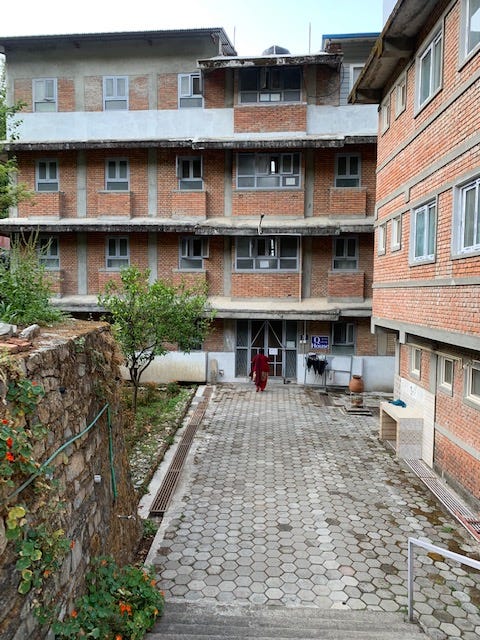
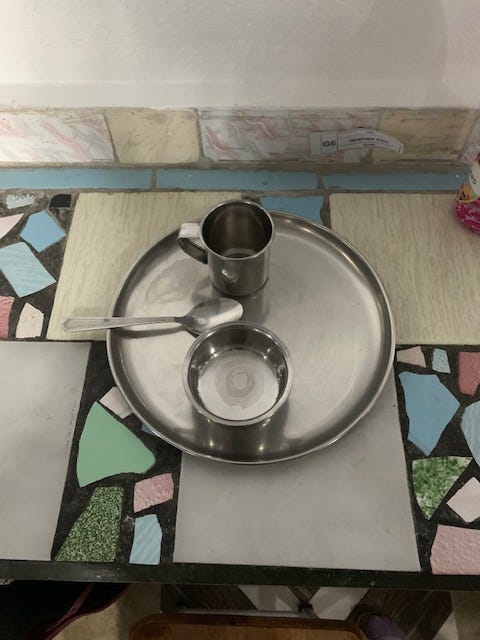
QUICK UPDATE
I’m writing this out on May 10, 2023. It’s Leslie & Lauren Randalls’ 35th birthday back in the US, and I just reached Jordan with my Palestinian family. We’ll be visiting Petra tomorrow—I’ll be able to share more about in a few posts. Honestly, so much has happened between finishing the 10 day course and now arriving in Jordan, it’ll be a minute before I can journal it all out!
Hey! Would you like to connect over creativity, self-growth, and problem-solving? Or just to have a virtual glass of wine or mocktail? Please book a time on my Calendly for us to chat! I can’t wait to see you. XOXO.
If you’re enjoying On the Road, please share with others who you may think would enjoy as well! As always, I love reading your comments and feedback. If you're not already subscribed, please click the button below so I can continue sending you weekly-ish stories and lessons while I travel. 🚙




I feel like if they sent criminals here, instead of to prison, they probably wouldn't end up back.
😂
Just reading about your experience has my hips, back, and feet hurting.😂
Just hearing you talk about how extremely difficult this was makes it so much more real. Thanks for sharing this story so far!